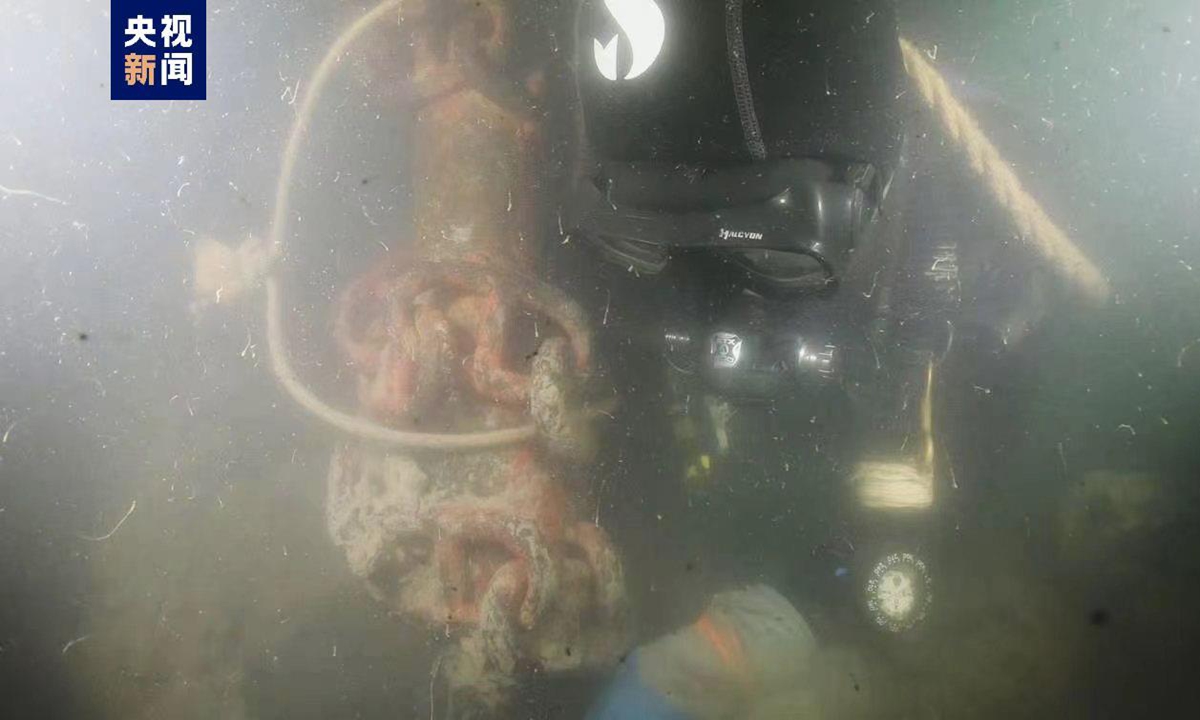ARTS / CULTURE & LEISURE
1st Sino-Japanese War artifacts on exhibition at Shandong Museum

Archaeolgists are underwater to find relics of the ship wreckage named Jing Yuan sunk in the First Sino-Japanese War (1894-95) during the Qing Dynasty (1644-1911) off the coast of Weihai, East China's Shandong Province, reported China's Central Television on March 4, 2023. Photo: Screenshot from online
About 330 artifacts unearthed from the warships that sank during the First Sino-Japanese War (1894-1895) went on display in East China's Shandong Province on Sunday. In addition to ship components, weapons and ammunition, the exhibition also showcases many daily items used by the crew. These include sailor ID tags, name-engraved telescopes, porcelain bowls, leather shoes, mahjong tiles, chess pieces, buttons and perfume bottles, according to a report by the Xinhua News Agency.The exhibition titled Bear in Mind the History - The Exhibition of Sino-Japanese Navel War and Underwater Archaeological Finds from the Warship Wrecks commenced at the Shandong Museum on Sunday in Shandong Province.
2024 marks the 130th anniversary of the First Sino-Japanese War, commonly known in China as the Jiawu War. It began on July 25, 1894, when Japanese warships attacked two Chinese vessels near the Korean port of Asan. It concluded with the signing of The Shimonoseki Treaty, which ceded the Liaodong Peninsula in Northeast China, the island of Taiwan, and the nearby Penghu Islands to Japan in April 1895.
This year also marks the 10th anniversary of the Jiawu shipwreck underwater archaeological project. The discovery of the Zhiyuan shipwreck site in 2014 marked the beginning of a series of underwater archaeological explorations of ships sunk during the First Sino-Japanese War.
Over the past decade, the wrecks of seven ships have been found in the Yellow Sea off the coast of Liaoning and Weihai Bay in Shandong, yielding thousands of precious artifacts.
Featuring about 330 artifacts, this exhibition is the first systematic display of artifacts recovered from five shipwrecks in different seas. One notable exhibit is an 11-mm Gatling gun from the Zhiyuan warship. This artifact was recovered in 2014 from the Zhiyuan wreck site near Dandong, Liaoning. The gun measures 117 centimeters in length with an outer barrel diameter of 18 centimeters. As it was covered in the remnants of marine life and minerals when discovered, it took a year to restore and preserve it.
"This exhibition showcases underwater archaeological achievements in the past 10 years and the preservation of revolutionary relics," said Sun Yanli, deputy director of the revolutionary relics department at the Shandong Museum and one of the exhibition curators.
According to Sun, the exhibition is divided into three sections: the first part reviews China's modern naval defense and the rise and fall of the Beiyang Fleet of the Qing Dynasty (1644-1911); the second part systematically showcases the underwater archaeology and research findings surrounding the Jiawu shipwrecks; and the third part highlights the mission of underwater archaeologists and cultural heritage workers to uncover hidden histories and interpret the unique cultural heritage of Chinese civilization.
"Underwater archaeology has explored the trade and cultural exchanges of the Chinese nation throughout its development, as well as wars," said Sun Jiashan, an associate researcher at the Central Academy of Culture and Tourism Administration, told the Global Times on Monday.
"The revolutionary relics exhibition uses artifacts to help visitors understand what the Chinese nation has gone through to reach the present day, showcasing both its hardships and moments of glory," Sun noted.



